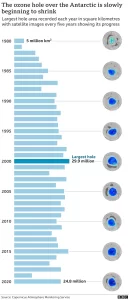An international agreement in 1987 to stop using the harmful chemicals that were damaging the layer has been successful, the major assessment says.
The ozone layer is a thin part of the Earth’s atmosphere that absorbs most of the ultraviolet radiation from the Sun. When depleted, this radiation can reach the surface – causing potential harm to humans and other living things. Ultraviolet rays can damage DNA and cause sunburn, increasing the long-term risk of problems such as skin cancer. The ozone layer began depleting in the 1970s.
Chlorofluorocarbons (CFCs), commonly found in spray cans, fridges, foam insulation and air conditioners, were blamed for eating away at the ozone layer. A gaping hole in the layer was discovered by scientists in 1985. Two years later, the Montreal Protocol was signed – with 46 countries promising to phase out the harmful chemicals. The deal became the first UN treaty to achieve universal ratification, and almost 99% of banned ozone-depleting substances have now been phased out.
The Industry switched to “CFC-free” aerosol cans that appealed to green consumers.

The Antarctic ozone hole continued expanding until 2000, after which its area and depth began improving slowly. A report co-produced by UN, US and EU agencies says the Montreal Protocol works as hoped. It says that, if current policies are maintained, the ozone layer will be restored to 1980 values – before the ozone hole appeared – at different points in different places:
- 2066 over the Antarctic, where ozone depletion was the worst
- 2045 over the Arctic
in about two decades’ time, everywhere else. This environmental disaster which could have led to adverse consequences for humanity was deflected because of a joint effort between governments, industries and policymakers which proves that if we come together, other potent environmental problems that we face right now could be diverted or solved with collective effort.












